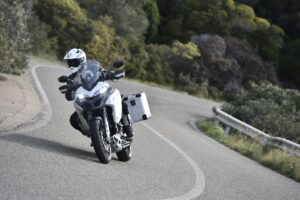Predictive Cornering
Predictive cornering is a strategy where I utilize primary and secondary indicators to compile all the available information to predict where the road is going, identify potential hazards, and reduce the compression of information. Eliminating one or more of the above strategies is often the cause or primary factor in riders crashing in curves. Predictive cornering is used to determine the following:

~ The radius of the corners
~ Oncoming hazards
~ Potential traction changes
~ The number of upcoming corners
~ Elevation changes
~ Bank and angle of the road
~ Traffic
The primary goal of predictive cornering is to reduce the speed at which information and decision-making is done by the rider. By reducing how fast information compacts, the rider can take action early and alter their plan as new information is obtained.
Why Predictive Cornering Matters
The vast majority of motorcycle fatalities in Washington (72%) consist of the rider failing to negotiate a curve successfully (2018 data). This percentage is mirrored in other U.S. states and westernized nations, such as New Zealand. Additionally, 32% of multi-vehicle accidents also involve a curve, where the bike ran out of their lane and struck another vehicle. Being unable to negotiate curves is the number one fatality, and is entirely the rider’s fault.
In 2016, three states looked at motorcycle fatalities involving a second vehicle and found that only 18-30% of those fatalities were considered the fault of the other vehicle. The good news is that we as riders mostly kill ourselves, which means we have control over preventing that fate.
Predictive cornering is part of a greater riding strategy called “Delayed Commitment Cornering” which I won’t be able to cover in a single blog post, but this cornering process is based on three basic assumptions:
- Speed. Most fatal accidents do not show evidence that the motorcycle reached a physical limit of traction or ground clearance prior to crashing. The conclusion is that riders seldom crash due to physical limitations caused by speed, but rather something else. The evidence points to rider fear (see #2).
- Fear. Evidence points to the primary cause of these fatal crashes being due to a rider’s fear. The information the rider is processing (ie. hazards, direction, road conditions, etc.) occurs faster than they can plan and react, causing them to panic and freeze or allow natural survival reactions to take over.
- Lack of Rider Skill. The final element shown in accident involved riders is an overestimation of one’s own abilities. This can be better understood by researching the Dunning-Kruger effect.

BRET TKACS
Click edit button to change this text. Lorem ipsum dolor sit amet consectetur adipiscing elit dolor